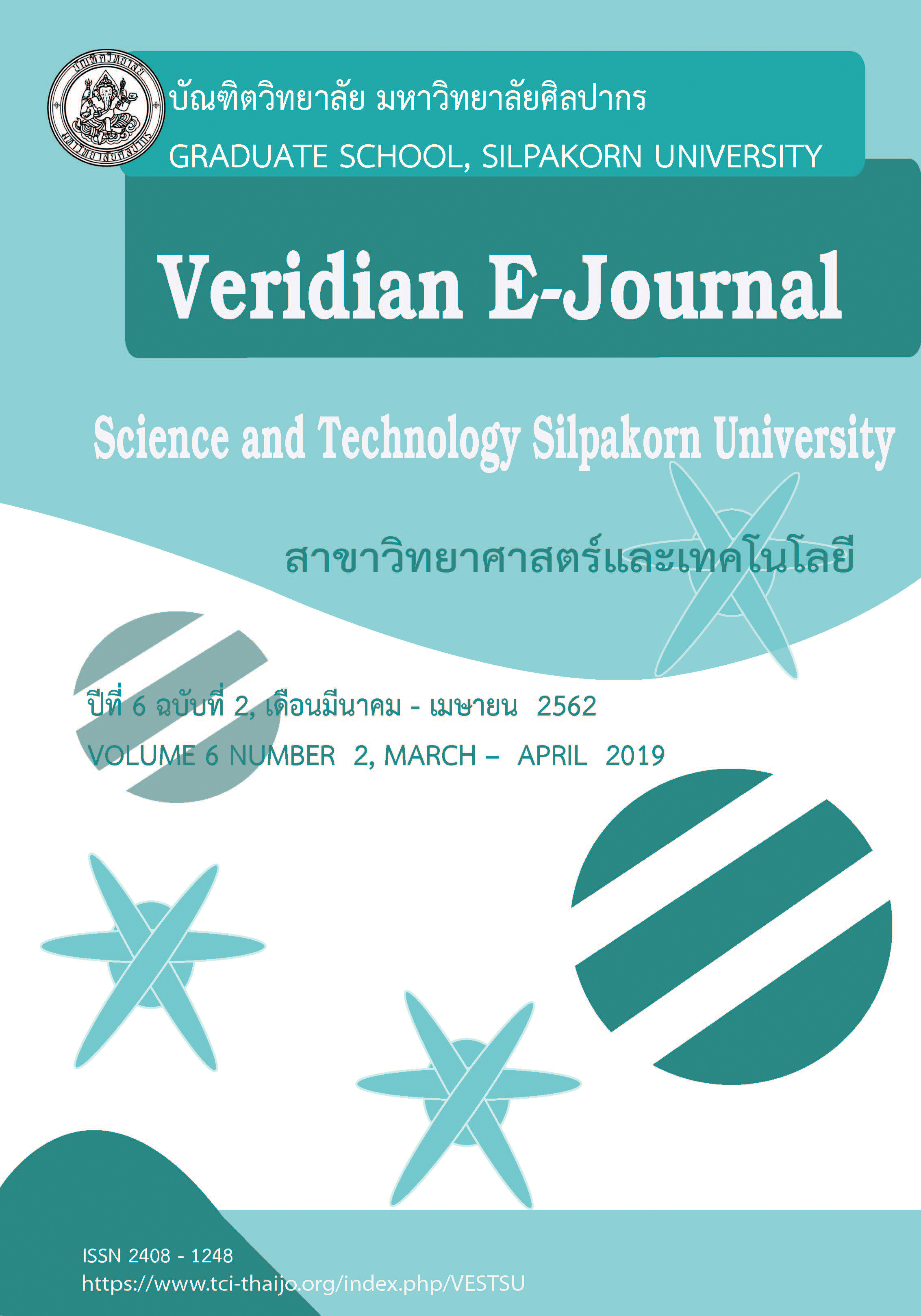การพัฒนาผลิตภัณฑ์ปาท่องโก๋ไขมันต่ำโดยใช้เปลือกเงาะผงเป็นสารลดการดูดซับน้ำมัน (Development of Low Fat Deep-fried Bun (Chinese Style) Product by Using Rambutan Peel Powder as Oil Reduction Substance)
Main Article Content
Abstract
ปาท่องโก๋เป็นอาหารทอดที่มีการดูดซับน้ำมันเป็นปริมาณมาก งานวิจัยนี้จึงมีวัตถุประสงค์เพื่อพัฒนาผลิตภัณฑ์ปาท่องโก๋ไขมันต่ำโดยใช้เปลือกเงาะผงเป็นสารลดการดูดซับน้ำมัน ขั้นตอนแรก ศึกษาชนิดของสารทำให้ขึ้นฟูที่เหมาะสมต่อการผลิตปาท่องโก๋ (ผงฟู ยีสต์ และแอมโมเนียมไบคาร์บอเนต) โดยออกแบบการทดลองแบบ Mixture design พบว่า สารทำให้ขึ้นฟูที่เหมาะสม คือ การใช้ยีสต์ ร้อยละ 0.7 ร่วมกับแอมโมเนียมไบคาร์บอเนตร้อยละ 0.7 ของปริมาณส่วนผสมปาท่องโก๋ ทำให้ผลิตภัณฑ์มีคุณภาพทางกายภาพ ได้แก่ ค่าความแน่นเนื้อต่ำ แต่ความสามารถในการคืนตัว และค่าปริมาตรจำเพาะสูงกว่าสูตรควบคุมและสูตรมาตรฐาน และได้รับคะแนนความชอบจากการทดสอบทางประสาทสัมผัสสูงในทุกคุณลักษณะ ขั้นที่สอง ศึกษาสมบัติทางเคมีและสมบัติเชิงหน้าที่ของเปลือกเงาะผง เตรียมเปลือกเงาะผงโดยการอบแห้ง บด และฟอกสีด้วยสารละลายไฮโดรเจนเปอร์ออกไซด์ความเข้มข้น 1.5 M พบว่า เปลือกเงาะผงมีใยอาหารทั้งหมด 79.60 g/100 g dry sample ใยอาหารที่ละลายน้ำ 3.02 g/100 g dry sample ใยอาหารที่ไม่ละลายน้ำ 76.58 g/100 g dry sample ปริมาณความชื้นร้อยละ 7.09 ค่า aw 0.29 ค่าความสามารถในการอุ้มน้ำ 7.70 g water/g dry sample และความสามารถในการอุ้มน้ำมัน 3.21 g oil /g dry sample และขั้นสุดท้าย ศึกษาผลของการเติมเปลือกเงาะผง (ร้อยละ 0 (ตัวอย่างควบคุม) 3 6 9 และ 12 ของปริมาณแป้งสาลี) ต่อคุณภาพของผลิตภัณฑ์ปาท่องโก๋ พบว่า ผลิตภัณฑ์ปาท่องโก๋ที่ไม่เติมเปลือกเงาะผง (ตัวอย่างควบคุม) และเติมเปลือกเงาะผงร้อยละ 3 ได้รับคะแนนความชอบสูงที่สุดไม่แตกต่างกัน (p>0.05) โดยผลิตภัณฑ์ปาท่องโก๋ที่เติมเปลือกเงาะผงร้อยละ 3 สามารถลดการอมน้ำมันได้ร้อยละ 29.44 เมื่อเทียบกับตัวอย่างควบคุม
Deep-fried bun is a fried food that adsorbs a lot of oil. This research was aim to develop a low fat deep-fried bun by using rambutan peel powder to be an oil reduction substance. First step, the suitable leavening agents (baking powder, yeast and ammonium bicarbonate) were investigated by using the Mixture design. The results showed that the appropriate leavening agent was 0.7% yeast and 0.7% ammonium bicarbonate (all ingredients basis). The obtained product was lower firmness but higher springiness and specific volume than the control and basic formulation samples. The sensory evaluation of the bun showed the high liking score for all attributes. Second step, the chemical and functional properties of rambutan peel powder were studied. Rambutan peel powder was prepared by drying, grinding and bleaching in 1.5 M hydrogen peroxide solution. The results revealed that this powder contained total dietary fiber of 79.60 g / 100g dry sample, soluble dietary fiber of 3.02 g / 100g dry sample, Insoluble dietary fiber of 76.58 g / 100 g dry sample, moisture content of 7.09%, aw of 0.29, water retention capacity of 7.70 g water / g dry sample and oil retention capacity of 3.21 g oil / g dry sample. Final step, the effect of rambutan peel powder (0 (control), 3, 6, 9, and 12 % (flour basis)) on the quality of the deep fried bun products was investigated. The results showed that both control and 3% rambutan peel powder added products had the highest liking score with no significant difference (p>0.05). The oil uptake of the 3% rambutan peel powder added product was reduced by 29.44% as comparing with the control.

